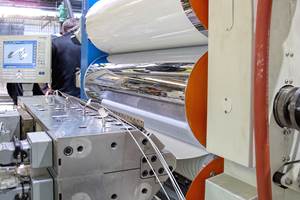Mission (Nearly) Impossible: Estimating Extrusion Melt Temperature
Extrusion Know How
Extrusion processors often ask screw designers to estimate the output and melt temperature of a new design in the works. Projected output of a new screw can usually be estimated fairly accurately. Melt-temperature estimate, however, is another story
Processors often ask screw designers or manufacturers to estimate the output and melt temperature of a new design in the works. Both bits of information are important to the success of the new design. The projected output of a new screw can usually be estimated fairly accurately using a limited amount of information supplied by the purchaser.
The melt-temperature estimate, however, is another story. It’s far more complicated to determine and generally can only be approximated based on comparisons of similarly designed screws processing the same polymer. The problem with estimating melt temperature accurately is not related to the screw, but to the lack of information on the extruder in which the screw will be installed.
Remember this principle: The screw is not a complete processing system. It interacts with the rest of the extruder, and unless extensive data is collected on the exact extruder in question, melt-temperature estimates are just that—estimates.
Melt temperature will vary depending on a long list of variables. Some of these are: barrel wear; head pressure; heater placement; heating and cooling capacity of barrel heaters; barrel liner material/thickness; thermocouple placement; temperature controllers; polymer thermal, physical, and particle properties; screw speed; feed-throat and screw cooling; accuracy of output estimate; alignment; incoming polymer temperature; and operating environment.
The extruder is a complex thermal device that takes energy from the drive and converts it to heat to melt the polymer through a combination of friction, viscous dissipation, and conducted heat. Smaller additional amounts of power are required for solids and melt conveying. Power entering the system through the barrel heaters is generally a minor source compared with the drive. Power is lost through parts of the cooling system, the environment, and through mechanical losses in the drive and gear reducer. This is depicted in the accompanying illustration.
Accounting for this energy movement is nearly impossible without test data from the extruder in question. And it’s impossible to calculate the melt temperature accurately without such data.
Moreover, output and melt temperature vary with fluctuations in the polymer and head pressure. There is always at least some error introduced in the output calculation due to variations in the polymer, which affect the head pressure and melt temperature. Polymers can vary considerably among suppliers, even with the same general specification. Head pressure becomes a variable that is a “catch 22.” Even if you have logged head-pressure data at a specific output on a past run, don’t count on it being the same again. Head pressure will vary with any difference in the melt temperature.
Pellet geometry or the use of regrind will change output rates, thereby affecting melt temperature. Further, regrind can have substantial changes in rheology compared with virgin. So, to even estimate an accurate melt temperature requires data on the specific polymer being extruded, including any regrind. Just calculating where melting starts in a particular extruder is difficult without substantial test data. Naturally, that information is necessary to even begin a calculation of the final melt temperature.
Designers can utilize tools to perform more accurate melt-temperature calculations. Just keep in mind that such an analysis can cost more than the screw. It’s best to supply screw designers with the current screw design and complete operating conditions so that they can make the most accurate estimates. By modeling the performance of the current screw, an experienced designer can factor in many of the variables without collecting all the data.
Related Content
Medical Tubing: Use Simulation to Troubleshoot, Optimize Processing & Dies
Extrusion simulations can be useful in anticipating issues and running “what-if” scenarios to size extruders and design dies for extrusion projects. It should be used at early stages of any project to avoid trial and error and remaking tooling.
Read MoreRoll Cooling: Understand the Three Heat-Transfer Processes
Designing cooling rolls is complex, tedious and requires a lot of inputs. Getting it wrong may have a dramatic impact on productivity.
Read MoreHow To Identify Resin Degradation in Single-Screw Extruders
Degradation can occur in many single-screw extrusion operations, and typically occurs due to minor design flaws in the screw. Here is how to track it down.
Read MoreNPE2024 Wrap-Up: Sustainability Dominates Show Floor News
Across all process types, sustainability was a big theme at NPE2024. But there was plenty to see in automation and artificial intelligence as well.
Read MoreRead Next
Beyond Prototypes: 8 Ways the Plastics Industry Is Using 3D Printing
Plastics processors are finding applications for 3D printing around the plant and across the supply chain. Here are 8 examples to look for at NPE2024.
Read MoreLead the Conversation, Change the Conversation
Coverage of single-use plastics can be both misleading and demoralizing. Here are 10 tips for changing the perception of the plastics industry at your company and in your community.
Read MoreFor PLASTICS' CEO Seaholm, NPE to Shine Light on Sustainability Successes
With advocacy, communication and sustainability as three main pillars, Seaholm leads a trade association to NPE that ‘is more active today than we have ever been.’
Read More.jpg;width=70;height=70;mode=crop)













